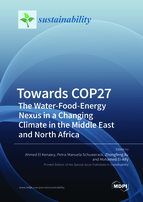Towards COP27: The Water-Food-Energy Nexus in a Changing Climate in the Middle East and North Africa
A special issue of Sustainability (ISSN 2071-1050). This special issue belongs to the section "Sustainable Water Management".
Deadline for manuscript submissions: closed (30 September 2022) | Viewed by 45306
Special Issue Editors
Interests: climate change; climate variability; atmospheric physics; hydrology; environment; spatial analysis; environmental impact assessment; water resources management; geographic information system; remote sensing
Interests: integrated approach to complex interactions of man-made and natural impacts/hazards on aquatic systems; integrated ecotoxicology fornon-linear aquatic systems; coastal protection against natural hazards; integrated disaster management, evaluationand community resilience
Interests: land-atmosphere interaction and its impact on climate variability; development of dynamical downscaling method (Specially focusing on how to constrain the GCM and RCM systematic biases during downscaled simulation); monsoon climatology
Interests: hydrogeology of arid zones; hydrochemistry, GIS and remote sensing, groundwater modeling; surface water–groundwater interactions; geostatistics
Special Issues, Collections and Topics in MDPI journals
Special Issue Information
Dear Colleagues,
The global hydrological cycle will be affected by climate change, which will have an impact on water supply and demand, food production, as well as energy generation. Global issues such as human well-being, poverty reduction, and sustainable development are all intertwined with an increasing demand for finite resources in the water–food–energy nexus. Recalling that resources have become increasingly scarce, countries—particularly developing ones—are struggling to provide enough water and energy to meet the growing demands of their populations, especially their food needs. In this case, the ability to keep a steady supply of important resources is very important for the long-term survival of a region.
Due to its low capacity to adapt to climate change’s negative impacts, the Middle East and North Africa (MENA) region is considered a “hot spot” region in terms of climate change. Countries in the region are already experiencing a range of climate change impacts (e.g., water scarcity, extreme heat, drought, crop failure), which are expected to worsen as the region’s population, urbanization, and industrialization continue to rise. As a result of a series of civil conflicts, ethnic conflicts, terrorism, and political and socioeconomic instability, water stress and food insecurity are exacerbated in the region. This is resulting in an increase in the flow of refugees to neighboring regions, particularly Europe. In the region, there is a lack of understanding of how changes in the climate system affect the water–food–energy nexus. For a robust assessment of the possible impacts of climate change in the region, all of these issues must be empirically evaluated and quantified. A comprehensive understanding of this nexus in the MENA region is highly desired, given that policymakers face unprecedented challenges in terms of population growth, rapid urbanization, food safety, and climate change, alongside the global goal of reducing greenhouse gas emissions (as planned in COP27). In order to deal with these challenges, the adaptation and mitigation strategies are complex and related. Changing one aspect of the water–food–energy–climate nexus can have unintended and detrimental effects on other aspects. As such, managing the compound resources system within a holistic analytical framework is necessary in order to achieve long-term sustainability goals. With an emphasis on climate-centric thinking, an innovative water–food–energy nexus should be adopted for the MENA region. These integrated approaches can motivate social-economic development in the region, ensure resource security, mitigate global warming, and meet the conflicting interests of multiple stakeholders.
Climate-related disciplines such as hydrology, agriculture, ecology, environmental science, and other related fields are the focus of this Special Issue, which aims to examine the interactions between water, food, energy, and climate in the MENA region. This SI will help to better understand the effects of climate change on hydrological processes, natural disasters, water supply quality, energy production and demand, and environmental impacts in the region, as well as the testing and exploitation of sustainable and efficient solutions for challenges in the water, food, energy, and climate sectors on different spatial scales (e.g., local, regional, as well as the whole domain). In pursuit of this background, this Special Issue will cover, but not be limited to, the following topics in the region:
- Integrated groundwater and storm water management systems.
- Integrated assessment and modeling of freshwater and wastewater management systems.
- Integration of big data analytics for defining and determining a knowledge framework for environmental impact assessment.
- Sustainable management of marine and coastal environments.
- Impacts of climate change on agricultural ecosystems.
- Environmental and ecological impacts of climate hazards.
- Future projections and simulations of climate change impacts.
- Renewable and green energy.
- Biotechnology for environmental risk assessment and management.
- Innovative and clean technologies for energy production.
- Smart cities and climate change resilience.
- Remote sensing and GIS applications for sustainable monitoring.
Publication fees of this special issue will be covered by Mansoura University (Egypt).
Dr. Ahmed El Kenawy
Dr. Petra-Manuela Schuwerack
Dr. Zhongfeng Xu
Dr. Mohamed El-Alfy
Guest Editors
Manuscript Submission Information
Manuscripts should be submitted online at www.mdpi.com by registering and logging in to this website. Once you are registered, click here to go to the submission form. Manuscripts can be submitted until the deadline. All submissions that pass pre-check are peer-reviewed. Accepted papers will be published continuously in the journal (as soon as accepted) and will be listed together on the special issue website. Research articles, review articles as well as short communications are invited. For planned papers, a title and short abstract (about 100 words) can be sent to the Editorial Office for announcement on this website.
Submitted manuscripts should not have been published previously, nor be under consideration for publication elsewhere (except conference proceedings papers). All manuscripts are thoroughly refereed through a single-blind peer-review process. A guide for authors and other relevant information for submission of manuscripts is available on the Instructions for Authors page. Sustainability is an international peer-reviewed open access semimonthly journal published by MDPI.
Please visit the Instructions for Authors page before submitting a manuscript. The Article Processing Charge (APC) for publication in this open access journal is 2400 CHF (Swiss Francs). Submitted papers should be well formatted and use good English. Authors may use MDPI's English editing service prior to publication or during author revisions.








